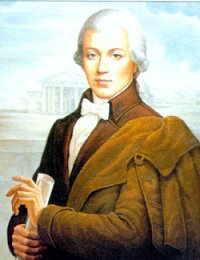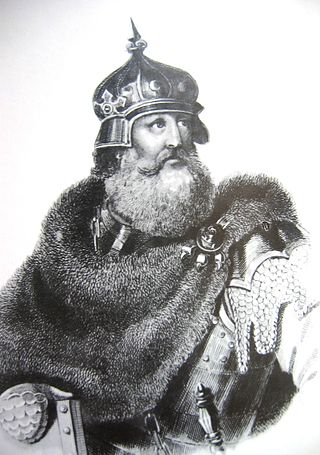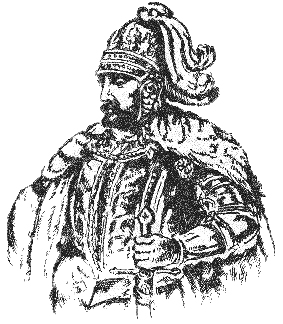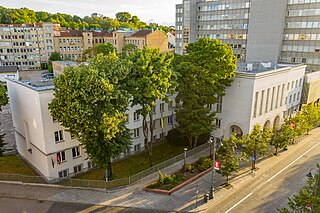
Following is a list of notable architects from Lithuania.

Following is a list of notable architects from Lithuania.

Kęstutis was the Grand Duke of Lithuania. He was the Duke of Trakai and governed the Grand Duchy of Lithuania, 1342–1382, together with his brother Algirdas, and with his nephew Jogaila.

Jaunutis was Grand Duke of Lithuania after his father Gediminas died in 1341 until he was deposed by his elder brothers Algirdas and Kęstutis in 1345.

The House of Gediminid or simply the Gediminids were a dynasty of monarchs in the Grand Duchy of Lithuania that reigned from the 14th to the 16th century. A cadet branch of this family, known as the Jagiellonian dynasty, reigned also in the Kingdom of Poland, Kingdom of Hungary and Kingdom of Bohemia. Several other branches ranked among the leading aristocratic dynasties of Russia and Poland into recent times.

The Columns of Gediminas or Pillars of Gediminas are one of the earliest symbols of Lithuania and its historical coats of arms. They were used in the Grand Duchy of Lithuania, initially as a rulers' personal insignia, a state symbol, and later as a part of heraldic signs of leading aristocracy.

Demetrius of Liubar or Liubartas was Prince of Lutsk and Liubar (Volhynia) (1323–1383), Prince of Zhytomyr (1363–1374), Grand Prince of Volhynia (1340–1383), Grand Prince of Halych–Volhynia (1340–1349).
Jaunė was daughter of Prince Ivan of Polatsk and wife of Gediminas, the Grand Duke of Lithuania (1316–1341). She is mentioned in written sources only once – the Bychowiec Chronicle, a late and unreliable source. Therefore, some historians cast a serious doubt on her existence, but modern reference works still widely cite her as the ancestress of the Gediminids dynasty.

The Catholic Church in Lithuania is part of the worldwide Catholic Church, under the spiritual leadership of the Pope in Rome. Lithuania is the world's northernmost Catholic majority country. Pope Pius XII gave Lithuania the title of "northernmost outpost of Catholicism in Europe" in 1939.

Senieji Trakai Castle was a castle in Senieji Trakai, Lithuania.

Senieji Trakai is a historic Lithuanian village located 3 kilometres (1.9 mi) east of Trakai. According to the Lithuanian census of 2011, it has 1,396 inhabitants – Lithuanians, Poles and Russians. The Saint Petersburg–Warsaw Railway passes through Senieji Trakai.
Danutė is quite popular female given name in Lithuania. Women named Danutė include:

Constitutional Court of the Republic of Lithuania is the constitutional court of the Republic of Lithuania, established by the Constitution of the Republic of Lithuania of 1992. It began the activities after the adoption of the Law of Constitutional Court of the Republic of Lithuania on 3 February 1993. Since its inception, the court has been located in Vilnius.

The family of Gediminas is a group of family members of Gediminas, Grand Duke of Lithuania, who interacted in the 14th century. The family included the siblings, children, and grandchildren of the Grand Duke and played the pivotal role in the history of Lithuania for the period as the Lithuanian nobility had not yet acquired its influence. Gediminas was also the forefather of the Gediminid dynasty, which ruled the Grand Duchy of Lithuania from 1310s or 1280s to 1572.

Andrei of Polotsk was the eldest son of Algirdas, Grand Duke of Lithuania, and his first wife Maria of Vitebsk. He was the Prince of Pskov and Polotsk (1342–1387). As the eldest son of the Grand Duke, Andrei claimed his right to the throne after his father's death in 1377. Algirdas left Jogaila, his eldest son with his second wife Uliana of Tver, as the rightful heir. Andrei's rivalry with Jogaila, Grand Duke of Lithuania and later King of Poland, eventually led to his demise.

The family of Kęstutis, Grand Duke of Lithuania (1381–1382), is listed here. He co-ruled with his brother Algirdas from 1345 to 1377.
Kęstutis Antanėlis was a Lithuanian composer, architect, and sculptor.
Kęstutis is a Lithuanian masculine given name and may refer to:

The Lithuanian Crusade was a series of campaigns by the Teutonic Order and the Livonian Order under the pretext of forcibly Christianizing the pagan Grand Duchy of Lithuania. The Livonian Order occupied Riga in 1202 and in the 1230s they settled in Chełmno Land, a fief of Poland. They first conquered other neighboring Baltic tribes—Curonians, Semigallians, Latgalians, Selonians, and Old Prussians—in the Livonian Crusade and Prussian Crusade.